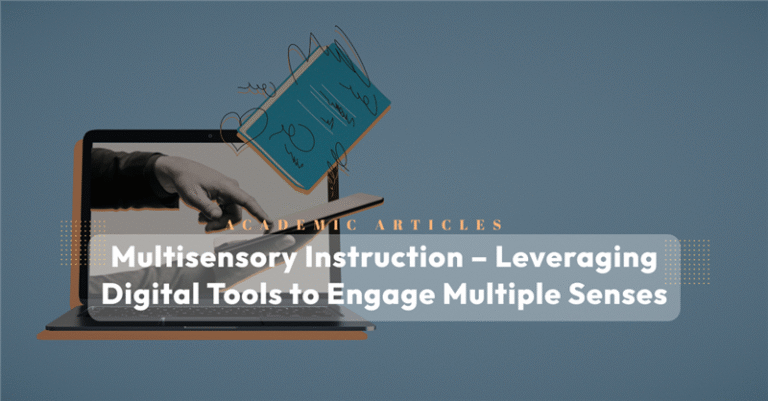Education is constantly changing and evolving. Thanks to online schools and learning platforms, teachers now have access to powerful tools that support multisensory instruction.
This method uses more than one sense at the same time. When done well, digital content that includes visuals, sound, and interactive features can help students understand, remember, and stay engaged with what they’re learning.
What is Multisensory Instruction?
Multisensory instruction refers to a teaching approach that involves the simultaneous use of multiple senses—typically visual (sight), auditory (hearing), and kinesthetic (movement or touch).
It’s based on the idea that students learn in different ways, and using multiple senses helps the brain understand and remember information better.
In a regular classroom, this might look like writing on the board while talking and asking students to repeat or act out what they’ve learned.
In online learning, this approach can be even more powerful, thanks to digital tools that offer interactive and engaging content in many different formats.
Key Elements of Digital Multisensory Instruction

- Visuals: Pictures, charts, animations, and videos help students see and better understand ideas that are hard to explain with just words. This is especially helpful in subjects like science and math, where some topics can be complicated or hard to imagine.
- Audio: Voice recordings, sound effects, and background music can help highlight important points, set the mood, or explain ideas more clearly. Sound also supports students who learn best by listening and can make it easier for those who struggle with reading to understand the material.
- Interactivity: Activities like quizzes, simulations, drag-and-drop tasks, and clickable lessons get students involved in the learning process instead of just reading or watching. This hands-on approach helps them think more deeply and understand the material better.
How Multisensory Digital Tools Enhance Comprehension
Digital tools allow educators to combine sensory inputs in ways that maximize understanding:
- Reinforcement of Concepts: For example, hearing an explanation while watching an animation helps the brain remember and recall the information more easily later on.
- Catering to Learning Styles: Students who find it hard to learn from reading can do much better when they have audio explanations or interactive visuals to help them understand.
- Improved Memory Retention: Multisensory learning activates different parts of the brain, which makes it easier to remember and recall information later.
- Increased Engagement: When lessons include interactive activities and different types of media, students are more likely to stay focused and take an active role in their learning.
Online Schools and the Power of Multisensory Instruction
Online schools are uniquely positioned to leverage the benefits of multisensory instruction.
Here’s how.
Personalized Learning Experiences
Online platforms can adjust to different learning styles by providing content in many formats—like videos, podcasts, e-books, and interactive activities.
This allows students to pick the way that helps them learn best. For example, a student who has trouble with reading can watch a video, while another might prefer listening to an audio summary.
Accessibility and Inclusion
Students with learning differences, like dyslexia or auditory processing issues, benefit from multisensory options.
Tools like text-to-speech, closed captions, transcripts, and visual aids help make sure every student can access and understand the content fairly.
Engagement Through Gamification
Many online schools include game-like features, such as interactive quizzes, badges, and points.
This gives students feedback and makes learning fun. These features engage different senses and keep students motivated.
Global Resources at Students’ Fingertips

Unlike traditional classrooms that mostly use textbooks, online schools offer large digital libraries, simulations, and virtual labs.
For example, a biology student can explore the human body using an interactive 3D model, listening to explanations while moving parts around for a hands-on learning experience.
Virtual labs can also be in a form of gamified content. Our biology tutor Sarah, explains this in our Let’s Talk About It Podcast episode.
Students play a game where they manage an ecosystem. Depending on what aspects they influenc,e they get different results.
For example, if they add predators in that ecosystem, they will change the number of particular species that are the prey.
However, if it is a snowy environment and they add a mutation to the species (white fur for example), they will have a better chance of survival.
This simulation helps students understand the subject by doing and participating, not by mere observation.
Consistent and Measurable Feedback
Multisensory tools such as interactive exercises and digital tests give students instant feedback.
This lets them learn from their mistakes right away, helping them understand better and encouraging a positive attitude toward learning.
Conclusion
Multisensory instruction combined with digital tools creates a rich and inclusive learning environment. It helps students connect more deeply with the material, improves understanding, and supports many different learning styles.
Online schools are leading this educational change by using technology not just to copy traditional teaching but to make it even better in ways we couldn’t imagine before. As education keeps changing, using digital tools for multisensory learning will be essential to help every student succeed.
Share, Discuss, or Ask
Do you have a child in an online school, or are you considering enrolling your child in one? We’d love to hear about your experiences. Let us know what has been or may be decisive in the dilemma of traditional vs. online.
If you have questions, please visit us at EduWW or email [email protected].



